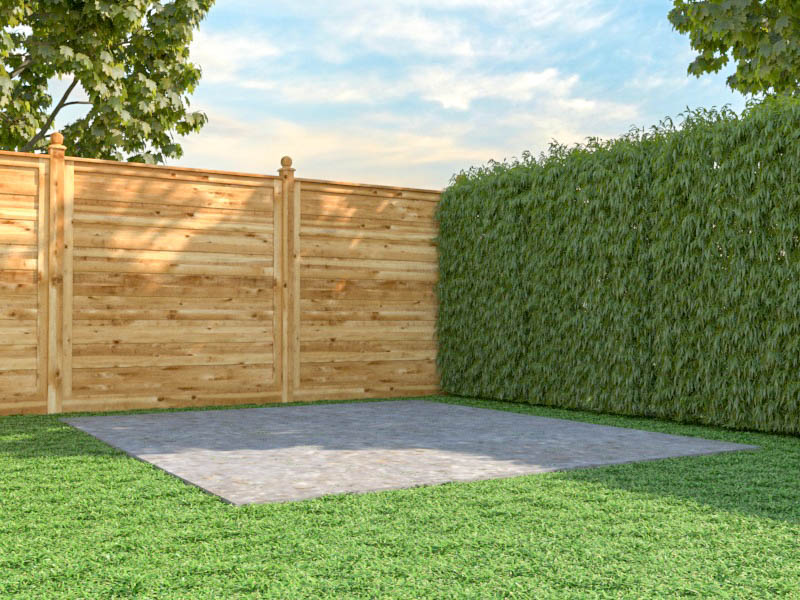Garden Office Foundations
Any building is only as good as its foundation system, and garden offices are no different.
A few years ago the only option when building a garden office was to create a concrete slab foundation, and while this remains a popular option with many suppliers, there are now a number of new garden office foundation options to choose from.
The site should dictate the style of foundation
While most suppliers have a preferred foundation system for their garden offices, the final choice should always be based on the site conditions. This is where a site visit comes into its own as it allows the supplier to assess the site and test the soil conditions to decide which foundation type is right for your garden.
Some companies don't conduct a site visit prior to starting work. They rely on you to describe the site. Typically, these firms will either ask you to have a concrete slab foundation installed before they arrive on-site, or rely on systems they have developed in-house which they believe can overcome any site issues once they arrive on-site. If you choose to work with a company who does not conduct a site survey, ask them about how they handle unforeseen site issues, and who will be liable, if work is delayed.
Concrete slab foundations
Concrete slab foundations have been used in garden office design since the early days, and they are still a popular and reliable choice today.

With concrete slab foundations, the vegetation is removed from the site, and the ground excavated - the depth will be dictated by the site conditions and the size of the building. A layer of hardcore is laid and then compacted to create a solid level base.
A timber framework is built for the concrete to be poured into. A damp proof membrane (DPM) is laid within this frame. On bigger projects, steel reinforcement bars will be fitted over the DPM, before the concrete is poured and levelled. Once the slab has set - this can take several days - the timber frame / shuttering is knocked away from the slab, and the DPM trimmed.
Concrete slab foundations are generally made to be about 50mm bigger than the footprint of the garden office; this offers a degree of tolerance to ensure the building is fully supported. This extra few millimetres of concrete will be hidden once the area is landscaped.
It takes skill to install a concrete slab. It is essential that the finished foundation is 'square', level and there are no undulations in the surface. This is why they have gone out of fashion with some suppliers, in addition, they are labour intensive, use a lot of materials and take time to set, so they are more expensive than other types of foundation.
It's worth checking if the garden office supplier organises the installation of the slab. Some suppliers specify them but expect the customer to find a local builder to install the base before they arrive with the building. If this is the case, you'll need to budget for the expense. The cost will be dependant on the size of your building, but as an example, for a 3m x 3m, you would need to budget in the region of £1,400.
If you are organising the installation of the concrete base, ask your office supplier to provide you with a plan for the foundation with the dimensions of the finished slab laid out. Also, ask them to confirm the constitution of the slab build-up that they require.
Plinth foundations
Plinth foundations have been popular with garden office designers for several years, for many reasons:
- They are simple to install and level so can be fitted by the general construction team.
- They don't involve wet materials so there is no setting time, meaning the garden office can be built as soon as the foundations are installed.
- They have strong eco credentials in that they can be removed cleanly from the site should the garden office ever be moved and they could then be reused.
- All these reasons make them cost effective too!
This type of foundation is usually included in the overall project cost.
The premise with plinth foundations is that a series of plinths. The number determined by the size of the building. Are spaced evenly within the footprint of the building. These plinths are made up of a base pad and a top pad which has adjustable fixings which are fixed into the joists.
There are three key brands of plinth foundation used by the garden office industry - Swift Plinths, Jack Pads and Easy Pad. These three systems work in much the same way, the materials used in their construction differ, some are made from concrete the others from plastic.
Plinth foundations can easily overcome problems with an uneven site. They have adjustable brackets which can overcome a shallow slope. For greater slopes, some systems make use of additional base pads to raise the foundation, while others fix timber stilts to the brackets, which are then fixed into the floor frame.
In most cases, plinth foundations are included in the cost of the garden office project.
Ground Screws
Where once, plinth foundations revolutionised garden office foundations, the new kid on the block. Ground screws have been widely adopted over the last couple of years. As the name suggests, a large screw is driven into the ground.
While a relatively new technique in the garden office industry. Ground screw piles have been used in domestic housebuilding and commercial building for many decades. Often overcoming very tricky site conditions.
With this system a large screw is driven by machine into the ground, the length chosen so that it gets down into the solid ground. The beauty of this system is that it is so easy to level an uneven site. Even a large site sloping in multiple directions can be levelled within a couple of hours. The head of each screw is then fitted with a bracket, which supports the floor frame.
The number of ground screws used depends on the site conditions and size of the building. They are spaced evenly within the footprint of the building. They can take great loads, larger ground screws taking 17 tonnes of axial pressure per screw – more than enough for your average garden office! There is a handy ground screw calculator that works out how many screws you will need for your job.
Companies like No More Digging can install ground screws for you, but there are also DIY options such as RADIX Ground Screw Piles which are worth exploring.
This is one of the quickest types of foundation to install. Typically, no ground clearance is undertaken before installation. Any grass will die back once the building is insitu and the light excluded. Once the positions have been marked for each screw, they are driven into place. A clever bit of kit is used to ensure each screw is driven in straight. The whole foundation system can be in place in just a few hours, levelled and ready to build upon.
Another reason that ground screws are becoming so popular is that they can be sited close to a boundary with relative ease. Maximising the space available. They are also being used when building in close proximity to a tree. During a site visit, the designer will assess the root system and calculate where the screws will be positioned to avoid the main roots. This is particularly useful when dealing with tree preservation orders.
Concrete pile foundations
A cross between a concrete slab and a plinth foundation that some garden office suppliers use are concrete pile foundations, evenly spaced under the garden office.
The size and depth of the pile depending on the site conditions and the size of the building and the method of anchoring the structure to the piles.
The ground is excavated down to solid ground, this is either dug by hand or by using a power auger which drills out the earth. Some suppliers then insert a former tube or timber shuttering into which, hardcore is compacted, and then the concrete poured in. These forms ensure a uniform shape, other suppliers just pour the concrete into the hole with a more rustic shape.
Depending on the choice of fixing, some suppliers will insert metalwork into the wet concrete; this has adjustable fixings which will attach to the floor frame. Other suppliers will level the pile ready for concrete beams or steel frames or in some cases, the timber floor joists to sit directly on the piles.
Custom foundation systems
A few garden office companies have developed their own foundation systems, in many cases a hybrid of those already described. One method makes use of similar concrete pad stones as used in the plinth foundation systems mixed with telescopic steel columns in the corners of the building. These adjustable steel posts mean the system can be used to overcome sharply sloping ground.
Another system we see used quite regularly is a steel perimeter frame that has adjustable feet. These feet sit on concrete blocks. These feet can be quickly levelled and work start immediately on the rest of the build.
Is the foundation included in the cost of your building?
You'll need to ascertain if the foundation system is included in the price you are being quoted. Particularly if you are getting prices from more than one company. You want to ensure you are comparing like with like, and taking the foundation system out of the quoted package. Could make one garden office seem significantly cheaper than another.
If you are asked to organise the installation of the foundation before the building arrives, your supplier should be able to give you a good indication of the price, based on the size of office you are buying. Be aware though that it will be a significant cost. An average sized concrete slab foundation could easily cost a £1,500 to install.
You may also find these articles useful:
- Floor structure
- Wall structure
- Roof structure
- Site visits

